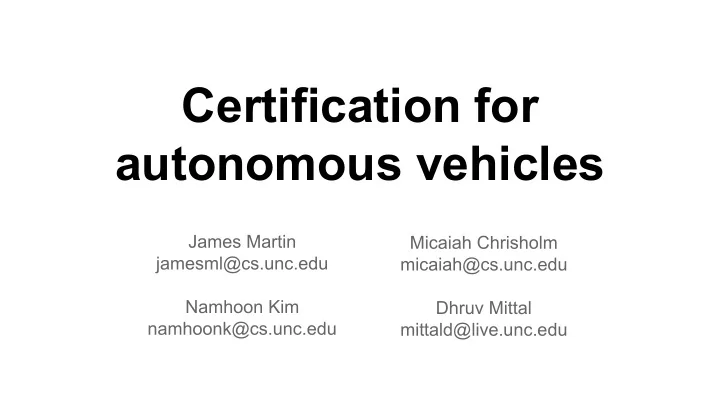

Certification for autonomous vehicles James Martin Micaiah Chrisholm jamesml@cs.unc.edu micaiah@cs.unc.edu Namhoon Kim Dhruv Mittal namhoonk@cs.unc.edu mittald@live.unc.edu
Introduction Why certify? - Maintain safety / protect consumers - Create industry standards What do current vehicle certifications look like? - Federal Motor Vehicle Safety Standards - Fairly robust document detailing everything from brake hoses to rearview mirrors - Testing procedures against standards
Introduction Using avionics as a model - What we can learn from the avionics industry Testing and verification - KeYmaera verification tool - Methods seen in industry
Introduction Certification and verification in software - Current standards that exist - How they are enforced Legislation and standards for software - IEC 61508 - Functional safety - ISO 26262 - Road vehicles: Functinal safety
NHTSA National Highway Traffic Safety Administration - Established in 1970 due to public outcry over vehicle safety - Responsible for: 1. maintaining/developing standards 2. enforcing standards - First standard was FMVSS 209 on Seatbelt Assemblies
NHTSA and automated vehicles Issued a statement with: 1. Recognition of benefits of these technologies 2. Acknowledging own role in the future of these technologies 3. Recommended principles for States Most thorough response to new technologies
NHTSA and automated vehicles Level 0 - No automation Level 1 - Function-specific automation (i.e. Electronic Stability Control) Level 2 - Combined function automation Level 3 - Limited self-driving automation Level 4 - Full self-driving automation
Recommendation from the NHTSA 1. Ensure drivers know how to operate a self- driving vehicle safely 2. Ensure that on-road testing minimizes risk to others 3. Make sure testing environment is suitable to technology 4. Establish reporting requirements to monitor performance while testing
Recommendations from the NHTSA 1. Ensure that transition from autonomy to driver is “safe, simple, and timely” 2. Be able to detect failures 3. No self-driving technologies should disable any federally regulated safety features 4. Record information about the self-driving technology in the event of a crash
FMVSS Federal Motor Vehicle Safety Standards and Regulations Broken into three main sections: 1. Crash avoidance (100-series) 2. Crashworthiness (200-series) 3. Post-crash survivability (300-series)
FMVSS No standard in the FMVSS covers software found in vehicles. Standard most important to us: - 101: Controls and Displays. All controls must be within reach of a belted driver - May have implications for autonomous vehicles
FMVSS Large hole in standards covering issues for autonomous vehicles Such as issues we’ve discussed: - Pedestrian detection - Collision avoidance
Testing procedures NHTSA website has 5 pages of test procedures. Highlights - Rigid Pole and Side Impact Protection - 214P/214D - Occupation Crash Protection - 208-14/208-13 - This is typically what people think of when they think of vehicle safety testing
NHTSA Crash Safety Test
Safety Ratings NHTSA will issue a safety rating out of 5-stars based on their testing Insurance Institute for Highway Safety (IIHS) also issues ratings for vehicle safety out of 5- stars
Quality control during manufacturing - Vendors must subject components to quality assurance before sending to manufacturer - Discretion of individual manufacturers Example: - Toyota plant in Georgetown, KY randomly selects 150-175 cars a day to be sent to a test track for thorough inspection
Analogous standards abroad Canada: CMVSS Australia: ADR, Australian Design Rules Korea: KMVSS Japan: Test Requirements and Instructions for Automobile Standards India: AIS, Automotive Industry Standards International: ECE, United Nations Economic Commision for Europe
Data collection Issues with privacy - Constant video being captured, possibly audio - Telemetry data collection - GPS - Fuel economy - Speed - Personally identifiable information (PII)
Current laws in place US legislation a “patchwork quilt” - No dedicated protection laws - Differ by industry - Developed on both state and federal levels Examples: - Electronic Communications Privacy Act - Driver’s Privacy Protection Act
Who enforces these laws? 1. Department of Justice 2. Department of Health and Human Services 3. Federal Trade Commission Currently the FTC would have enforcement authority - For entities not subject to industry specific regulation
Driver’s Privacy Protection Act Information held by the Departments of Motor Vehicles can only be released to “authorized recipients” such as: 1. Government agencies 2. Employers 3. Insurance companies 4. Licensed private investigation agencies
Driver’s Privacy Protection Act Should in-car data be covered by this law? - DMV probably not equipped to handle the bulk data - Having a list of “authorized recipients” would be a start Industry has been calling for additional government regulation
CES 2014 At CES 2014, Jim Farley, Ford’s Executive VP of Global Marketing: “We know everyone who breaks the law; we know when you’re doing it. We have GPS in your car, so we know what you’re doing” “By the way, we don’t supply that data to anyone.”
Ford’s response to Farley’s comment Data only used for “customer-relationship management purposes” - Mark Fields, COO Global Automakers Association issued a FAQ on Consumer Privacy Protection Principles
Global Automakers FAQ Highlights: 1. PII is collected 2. Customers have to opt-in to share data (signatures, verbal agreement, etc.) 3. Customers can review some data collected 4. Cannot turn off data collection 5. 19 automakers have agreed to the principles starting in 2016 (2017 model year)
Recommendations 1. New section in FMVSS standards dedicated to autonomous functionality 2. Creation of auto industry specific data protection laws that are enforced by a specific government agency like the NHTSA 3. Testing auto specific software for security and safety flaws
Sources http://www.toyotageorgetown.com/qualdex.asp http://www.bloomberg.com/news/articles/2014-01-14/ford-ceo-says-auto- industry-needs-privacy-boundaries-set-by-law http://www.globalautomakers.org/sites/default/files/Global%20Automakers% 20Privacy%20FAQs.pdf http://www.nhtsa.gov/Laws-Regs https://www.law.cornell.edu/uscode/text/18/2721
Recommend
More recommend